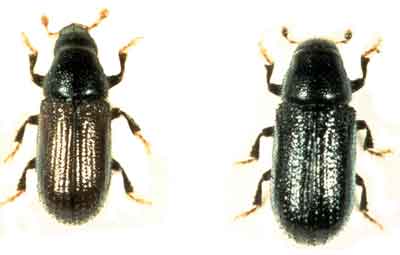Don’t remove pine shoot beetle trap logs too early
This year's cold spring is a good example of why growers should use growing degree-days to determine the window for collecting pine shoot beetle adults and destroying trap logs.

To better manage pine shoot beetles (Tomicus piniperda), you need to understand its life cycle. Adult pine shoot beetles overwinter at the base of live pine trees. In the early spring, these beetles leave their overwintering site and fly to suitable brood material, such as recently cut or killed stumps, logs or cut trees. The beetles chew their way under the bark, mate and the females lay eggs. The eggs hatch and the larvae – little, white grubs – feed for six to 10 weeks. They pupate and a new generation of adult beetles begins to emerge in early or mid-June.
Trap logs are used to trick the overwintering adult beetles when they are searching for brood material in spring. You set out nice, fresh pine logs, let the adult beetles colonize the logs, and then destroy the logs before the new generation of beetles can emerge.
It is a balance leaving the trap logs out long enough to be sure that you have trapped all the old adults, but then destroying them before any new beetles can emerge. Typically, Michigan State University Extension recommends using the window of May 1-20 to collect and destroy these trap logs. Due to the cool spring this year, it is better to use growing degree-days (GDD) to target the removal of trap logs from your fields. The trap logs must be collected and either chipped or burned starting at 200 GDD base 50 and finished by 350 GDD50.
Cover sprays are useful for controlling the new generation of beetles as they begin to shoot-feed in the summer. The best time to apply the cover spray is 400-450 GDD50, which is usually in early to mid-June.Use insecticide products containing either bifenthrin, chlorpyrifos or cyfluthrin.
Remember to keep records of everything you do such as when you put the trap logs out, collected them, when and how they were destroyed, insecticide applications made, etc.
To find GDDs for your area, go to MSU Enviro-weather.

Pine shoot beetle adults. Photo credit: E. Richard Hoebeke, Cornell University, Bugwood.org



 Print
Print Email
Email




